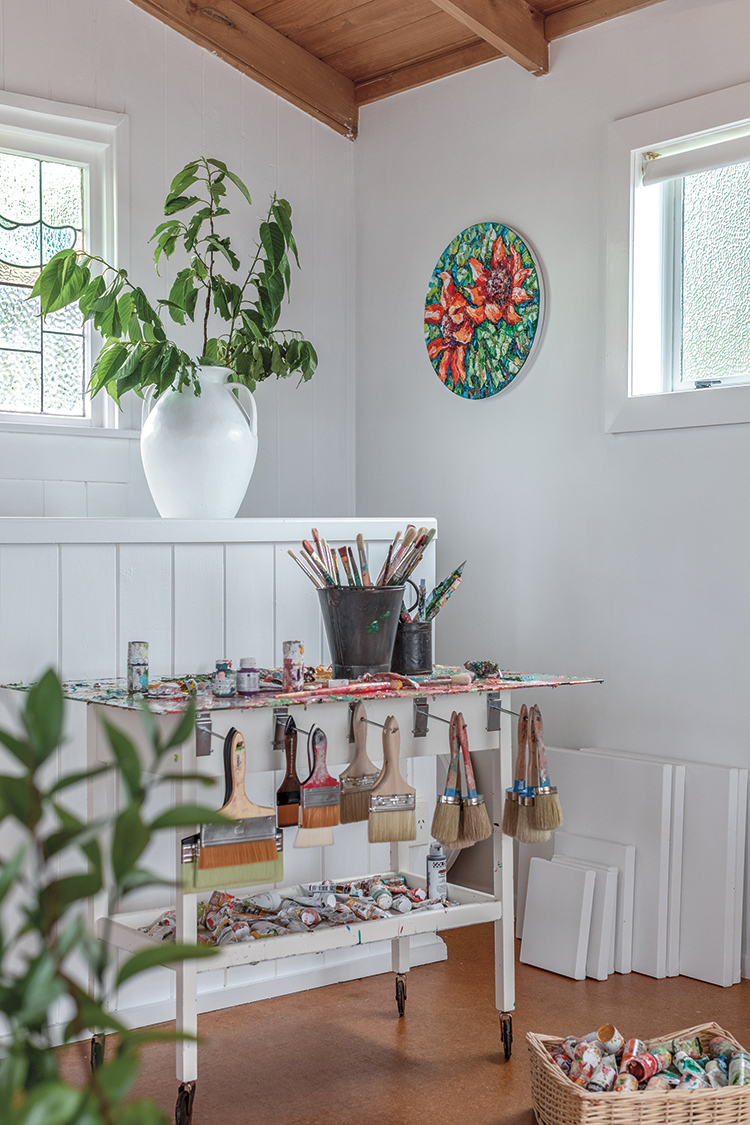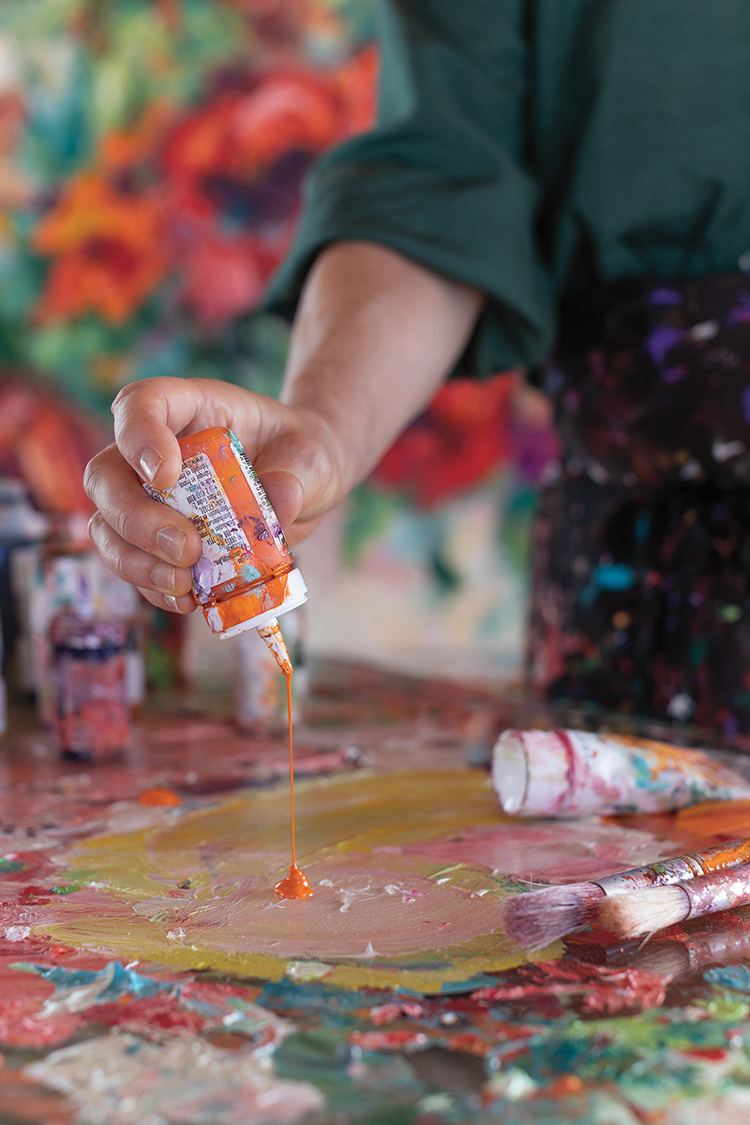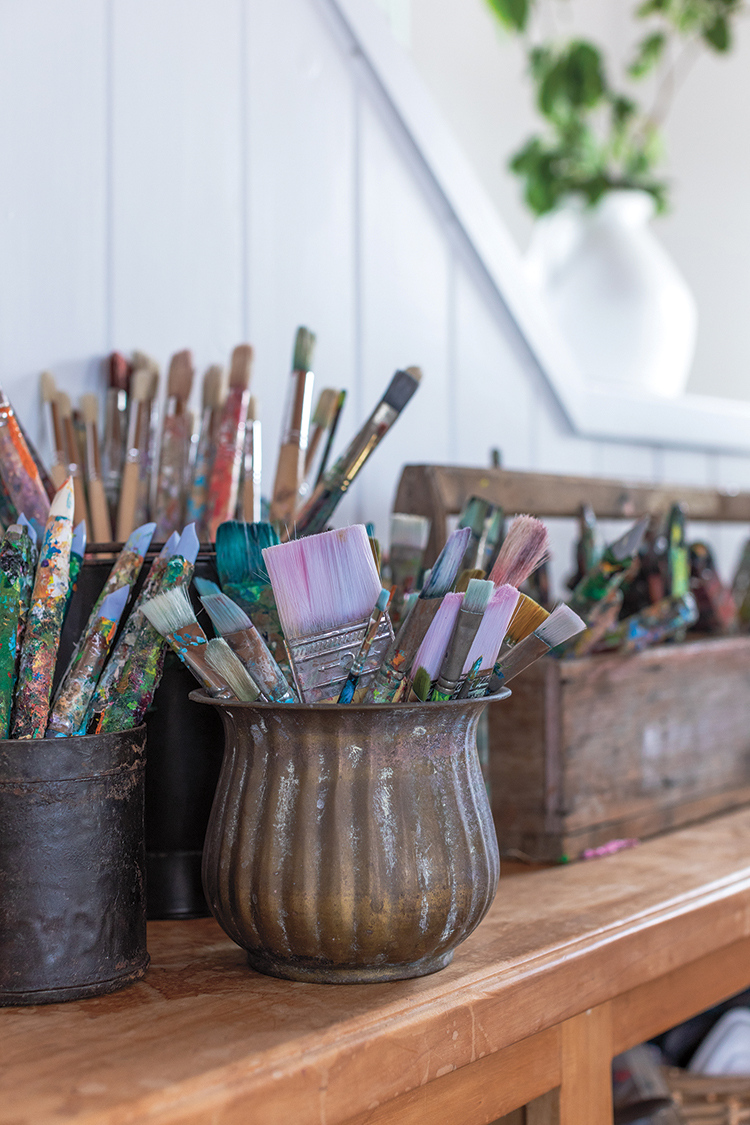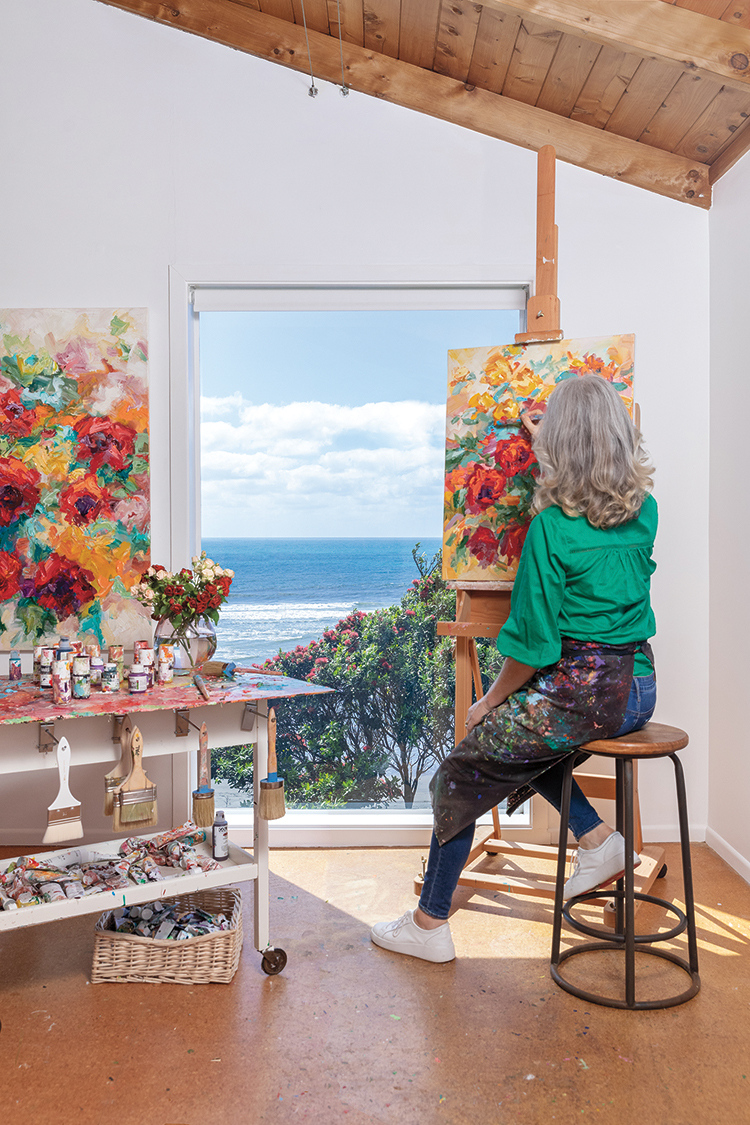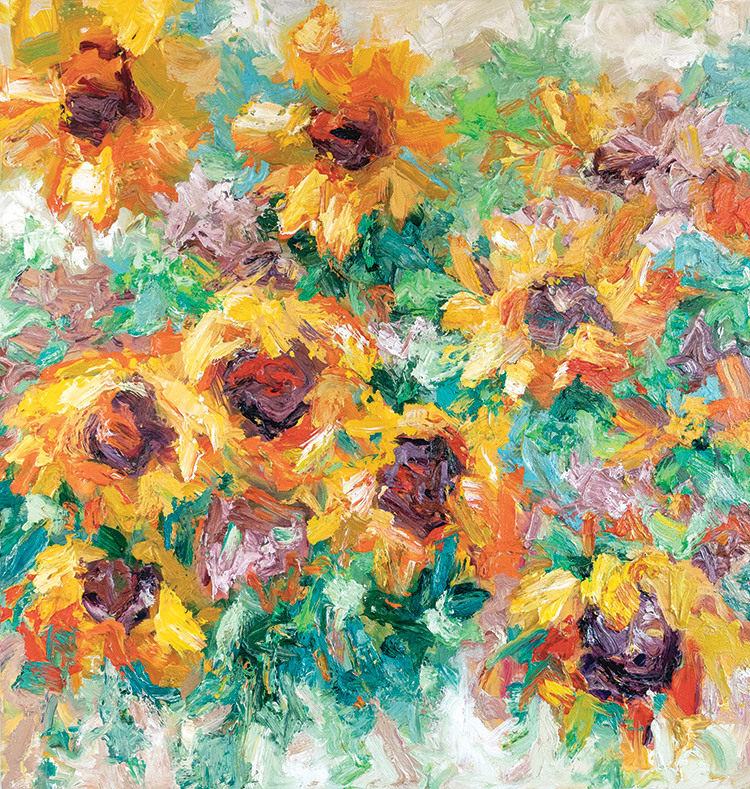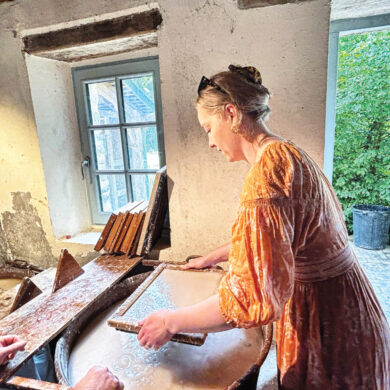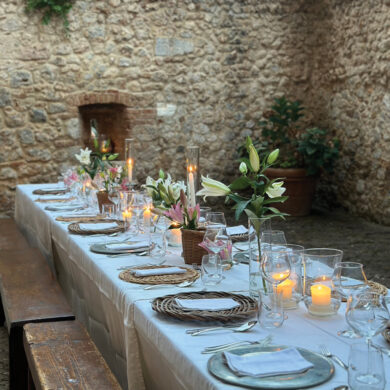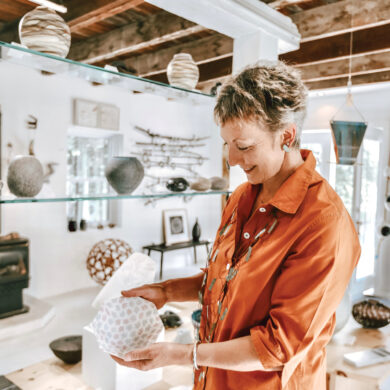As I climb the wooden stairs to my studio each morning, the sense of anticipation remains strong after 25 years working as a full-time artist. The alchemy of colour, paint, texture, form, and my interactions with these elements ensures no two days are alike—and I enjoy the fresh possibilities that each day presents.
Perched above a spectacular stretch of beach on New Zealand’s west coast is the rustic cottage my husband, Steve, and I have lived in for over 34 years. During this time, our home has evolved from a tiny seaside bach (a small and modest holiday home)—firstly to accommodate the arrival of our two daughters, Tess and Milla, and later to create my art studio on the second level overlooking the water. Simultaneously, my personal evolution enabled me to grow from teacher, to mother, to artist.
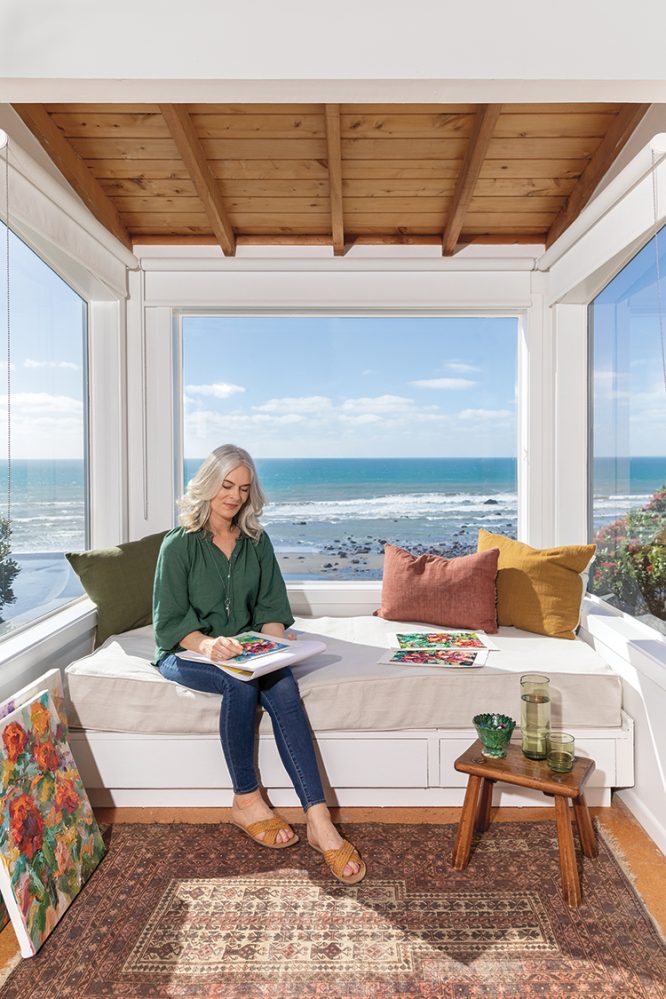
The journey to artist was a transformative process initiated by my experience with post-natal depression. Finding myself unexpectedly unwell after the birth of my second child, colour played an integral part in my recovery. Searching for a way to calm my anxious mind, I rediscovered a love for painting that I had put on hold since my art major at Wellington Teachers’ College. Daily painting became my colour therapy, bringing purpose to each day and creating light in what seemed an exceedingly long tunnel. As my confidence and enthusiasm for life slowly returned, I realised my illness had become a positive catalyst, opening the door to my life as a painter.
To this day, colour remains my constant inspiration. Living and working so close to nature, my painting palette remains influenced by the dramatic colours, vivid sunsets, and reflective black sand of the coastal environment. Outside my studio window is every shade of green foliage, and the large Pohutukawa tree blooms red each summer as a brilliant reminder of simultaneous contrast. Nature is my muse when planning the colour story for each new painting collection, and I am constantly gathering ideas. Collected as photos on my phone or sketches completed plein air with my box of oil pastels, many of these ideas I file for future reference.
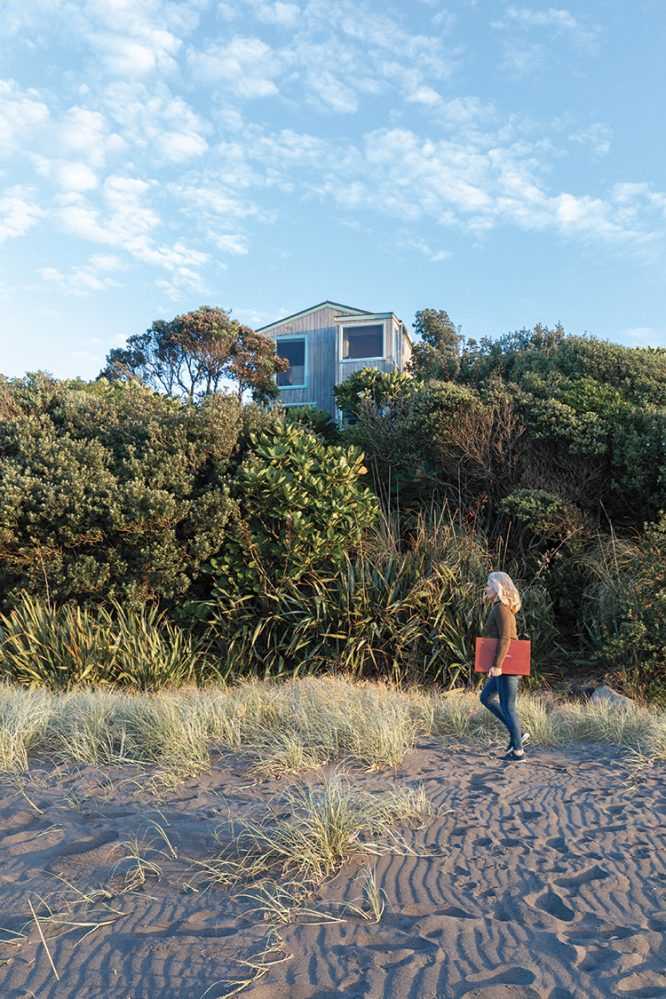
Light brings luminosity to colour and plays an important role in my work; from the clear, bright light of the Pacific to the gentle light experienced during our travels in Europe—there will never be enough paintings to explore all the possibilities.
“The whole world, as we experience it visually, comes to us through the mystic realm of colour.”
–Hans Hofmann
As a young artist, discovering my style became an area of immense growth. Initially, my paintings were in the contemporary realism style; within this genre sits the Pacifica series, depicting the view directly outside my studio window. The series celebrated New Zealand’s pristine coastline and native plants in vivid summery hues. In 2007, I shifted my gaze from the coast to the garden with the Lush series, transporting viewers through the garden paths and woodland blooms of nearby public gardens. But it was my growing fascination with paint—the sculptural texture of impasto and the spontaneous colour mixing of working alla prima—that gave birth to my popular Opulence series.
Within this series, I moved away from a literal depiction of the garden and explored floriography — the language of flowers. Published in Victorian times, floriography dictionaries assigned meanings to flowers and plants to send secret messages, and I became fascinated with the idea that I could add new symbols and associations to this bygone language—that each painting could hold deeper meaning.
An example of this floral storytelling is evident in the Gondwana collection, a group of paintings instigated by the 2020 Australian bushfires. With the fires creating an amber haze on the Taranaki horizon, I began researching how plants and trees survive such destruction without the necessary leaves for photosynthesis. What I discovered was many of these plants belonged to the proteaceae genera, a family of plants that had developed alternative methods of storing food beneath the ground.
These ancient plants dispersed and diversified throughout Gondwana before the breakup of the southern supercontinent and have since colonised around the globe. New Zealand’s variety is the rewarewa (New Zealand honeysuckle), Australia has the waratah, and South Africa the protea. When painting this collection, I represented the plants united in one bouquet as a collective symbol of the regenerative wisdom of plants.
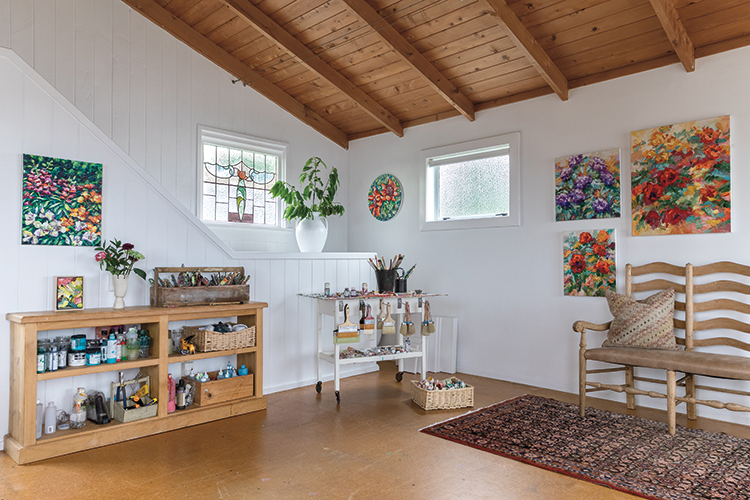
Finding the right business path is crucial to a successful art practice. As a young painter, I was fortunate to receive invitations to exhibit in Australian and New Zealand galleries early in my career. This helped set my place in the art market. Though, my best decision was the pursuit of an alternative method of selling my work. The year was 1999, and very few New Zealand artists, and even fewer dealer galleries, had a website presence. However, my accountant husband suggested that this new digital space could connect me directly to art buyers—he was right, and my work began to sell rapidly via a growing website mailing list. I also enjoyed connecting directly with buyers and collectors—one such collector now owns ten paintings she has purchased over the years. Launching a website generated international possibilities for my sales, and it continues to be a thrill that my paintings fly to interesting places around the world. Establishing systems to safely ship paintings, build marketing strategies, and grow as a businesswoman has been an interesting and rewarding part of my journey.
More recent developments include a new website designed and built by my daughter Milla. With her background in photography and digital design, she also convinced me to join Instagram, which initially I was concerned would eat into precious painting time. However, I now appreciate how well it complements what is already happening in my studio and the ongoing benefits of joining a wider community of creatives and art lovers.
Having a large, light-filled studio allows me the space to allocate zones for different work purposes. One wall is the ‘gallery’ where I hang and group finished paintings. I have recently added an antique bench to this area after stripping its dark varnish and recovering the base—this provides a not-too-comfortable seat to contemplate what is currently on the easel. The window seat is a more relaxed area to sketch or catch up with business tasks on the laptop. A work desk and extra storage shelves line the perimeter of the studio, creating a large open space in the middle for my easels. Painting knives live in an old toolbox that belonged to a dear friend and neighbour, while the glass-topped palette trolley was once an antique tea trolley and provides an ample surface for colour mixing. I like that most of the furniture and storage in my studio is reclaimed, recycled, or an antique find—there is a patina of age and the knowledge that these were once part of someone else’s life or creative pursuits.
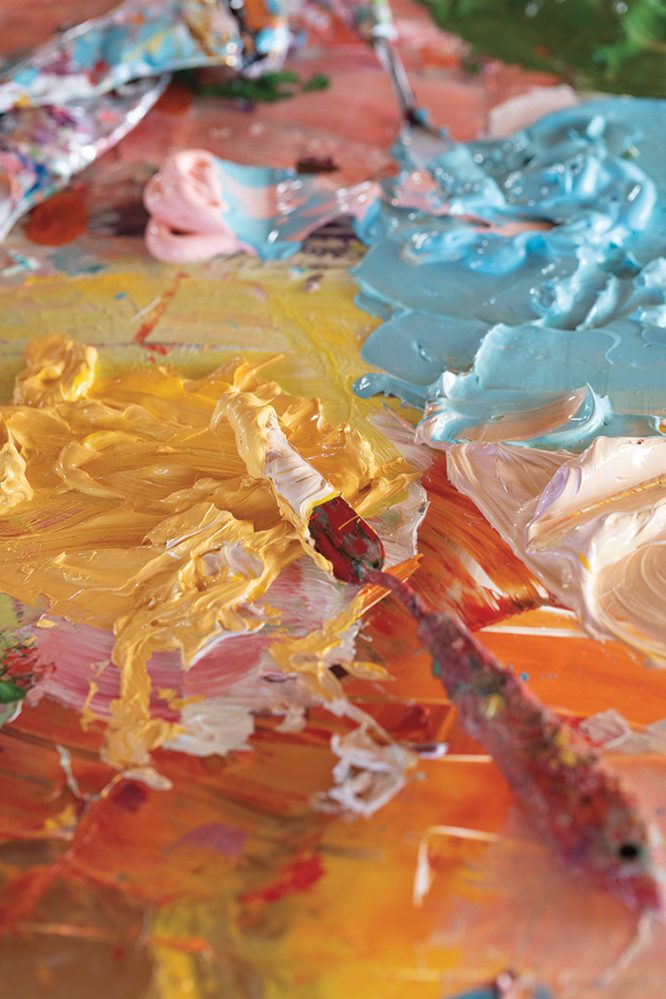
I have never met a colour I didn’t like, and my favourite hues are continually changing. Painting impasto requires large volumes of paint, so I find grouping them according to colour in the drawers of my work desk helps with the ongoing stock inventory. A sentimental item in my studio is my painting apron, which is covered with over twenty years of drips, splatters, and the occasional lazy paintbrush clean. One day, when it finally falls apart, I will frame it, as it represents so many paintings and personal history. But beyond all the practicalities, the most spectacular aspect of my studio is the sea and river views. During summer months, it can become difficult to remain focused with swimmers, horse and rider, dogs and owners, and surfers all having fun on the beach below.
Thankfully, there is always a spare moment for a quick dip in the sea to cool off during my workday. Winter brings squalls and storms, and at times, my studio feels more like a ship—I feel privileged to be so intimately in touch with the seasons and their shifting colours as I work.
“Colour has got me. I no longer need to chase after it. It has got me forever.”
—Paul Klee
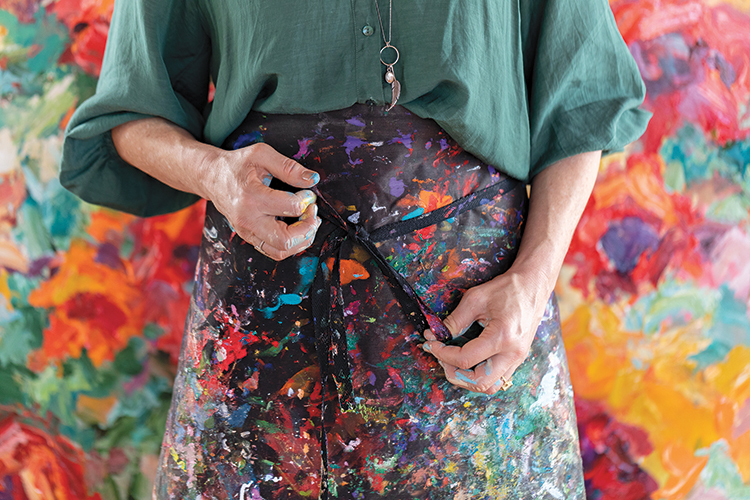
This year, I have found myself drawn to a more expressive use of colour, looser brushstrokes, freer forms, and larger canvases—percolating within me was a desire to create a new series that moved toward abstraction. Developing a new series takes energy; like a birthing process, it requires time to germinate, grow, and experiment. It also involves an element of ‘play,’ which is sometimes missing in the life of a professional artist. To facilitate this process, I began working exclusively on new ideas and playing with materials. The resulting series, titled Evoke, features loose, evocative florals.
Textural landscapes are yet to come, and I know these will give me more reason to eagerly anticipate my morning commute upstairs to the studio. There is certainly a confidence and a new excitement with where my work is heading. It is as though I have been diligently learning the language of colour and paint, and I now speak fluently.
As I climb the wooden stairs to my studio each morning, the sense of anticipation remains strong after 25 years working as a full-time artist. The alchemy of colour, paint, texture, form, and my interactions with these elements ensures no two days are alike—and I enjoy the fresh possibilities that each day presents.
Perched above a spectacular stretch of beach on New Zealand’s west coast is the rustic cottage my husband, Steve, and I have lived in for over 34 years. During this time, our home has evolved from a tiny seaside bach (a small and modest holiday home)—firstly to accommodate the arrival of our two daughters, Tess and Milla, and later to create my art studio on the second level overlooking the water. Simultaneously, my personal evolution enabled me to grow from teacher, to mother, to artist.

The journey to artist was a transformative process initiated by my experience with post-natal depression. Finding myself unexpectedly unwell after the birth of my second child, colour played an integral part in my recovery. Searching for a way to calm my anxious mind, I rediscovered a love for painting that I had put on hold since my art major at Wellington Teachers’ College. Daily painting became my colour therapy, bringing purpose to each day and creating light in what seemed an exceedingly long tunnel. As my confidence and enthusiasm for life slowly returned, I realised my illness had become a positive catalyst, opening the door to my life as a painter.
To this day, colour remains my constant inspiration. Living and working so close to nature, my painting palette remains influenced by the dramatic colours, vivid sunsets, and reflective black sand of the coastal environment. Outside my studio window is every shade of green foliage, and the large Pohutukawa tree blooms red each summer as a brilliant reminder of simultaneous contrast. Nature is my muse when planning the colour story for each new painting collection, and I am constantly gathering ideas. Collected as photos on my phone or sketches completed plein air with my box of oil pastels, many of these ideas I file for future reference.

Light brings luminosity to colour and plays an important role in my work; from the clear, bright light of the Pacific to the gentle light experienced during our travels in Europe—there will never be enough paintings to explore all the possibilities.
“The whole world, as we experience it visually, comes to us through the mystic realm of colour.”
–Hans Hofmann
As a young artist, discovering my style became an area of immense growth. Initially, my paintings were in the contemporary realism style; within this genre sits the Pacifica series, depicting the view directly outside my studio window. The series celebrated New Zealand’s pristine coastline and native plants in vivid summery hues. In 2007, I shifted my gaze from the coast to the garden with the Lush series, transporting viewers through the garden paths and woodland blooms of nearby public gardens. But it was my growing fascination with paint—the sculptural texture of impasto and the spontaneous colour mixing of working alla prima—that gave birth to my popular Opulence series.
Within this series, I moved away from a literal depiction of the garden and explored floriography — the language of flowers. Published in Victorian times, floriography dictionaries assigned meanings to flowers and plants to send secret messages, and I became fascinated with the idea that I could add new symbols and associations to this bygone language—that each painting could hold deeper meaning.
An example of this floral storytelling is evident in the Gondwana collection, a group of paintings instigated by the 2020 Australian bushfires. With the fires creating an amber haze on the Taranaki horizon, I began researching how plants and trees survive such destruction without the necessary leaves for photosynthesis. What I discovered was many of these plants belonged to the proteaceae genera, a family of plants that had developed alternative methods of storing food beneath the ground.
These ancient plants dispersed and diversified throughout Gondwana before the breakup of the southern supercontinent and have since colonised around the globe. New Zealand’s variety is the rewarewa (New Zealand honeysuckle), Australia has the waratah, and South Africa the protea. When painting this collection, I represented the plants united in one bouquet as a collective symbol of the regenerative wisdom of plants.

Finding the right business path is crucial to a successful art practice. As a young painter, I was fortunate to receive invitations to exhibit in Australian and New Zealand galleries early in my career. This helped set my place in the art market. Though, my best decision was the pursuit of an alternative method of selling my work. The year was 1999, and very few New Zealand artists, and even fewer dealer galleries, had a website presence. However, my accountant husband suggested that this new digital space could connect me directly to art buyers—he was right, and my work began to sell rapidly via a growing website mailing list. I also enjoyed connecting directly with buyers and collectors—one such collector now owns ten paintings she has purchased over the years. Launching a website generated international possibilities for my sales, and it continues to be a thrill that my paintings fly to interesting places around the world. Establishing systems to safely ship paintings, build marketing strategies, and grow as a businesswoman has been an interesting and rewarding part of my journey.
More recent developments include a new website designed and built by my daughter Milla. With her background in photography and digital design, she also convinced me to join Instagram, which initially I was concerned would eat into precious painting time. However, I now appreciate how well it complements what is already happening in my studio and the ongoing benefits of joining a wider community of creatives and art lovers.
Having a large, light-filled studio allows me the space to allocate zones for different work purposes. One wall is the ‘gallery’ where I hang and group finished paintings. I have recently added an antique bench to this area after stripping its dark varnish and recovering the base—this provides a not-too-comfortable seat to contemplate what is currently on the easel. The window seat is a more relaxed area to sketch or catch up with business tasks on the laptop. A work desk and extra storage shelves line the perimeter of the studio, creating a large open space in the middle for my easels. Painting knives live in an old toolbox that belonged to a dear friend and neighbour, while the glass-topped palette trolley was once an antique tea trolley and provides an ample surface for colour mixing. I like that most of the furniture and storage in my studio is reclaimed, recycled, or an antique find—there is a patina of age and the knowledge that these were once part of someone else’s life or creative pursuits.

I have never met a colour I didn’t like, and my favourite hues are continually changing. Painting impasto requires large volumes of paint, so I find grouping them according to colour in the drawers of my work desk helps with the ongoing stock inventory. A sentimental item in my studio is my painting apron, which is covered with over twenty years of drips, splatters, and the occasional lazy paintbrush clean. One day, when it finally falls apart, I will frame it, as it represents so many paintings and personal history. But beyond all the practicalities, the most spectacular aspect of my studio is the sea and river views. During summer months, it can become difficult to remain focused with swimmers, horse and rider, dogs and owners, and surfers all having fun on the beach below.
Thankfully, there is always a spare moment for a quick dip in the sea to cool off during my workday. Winter brings squalls and storms, and at times, my studio feels more like a ship—I feel privileged to be so intimately in touch with the seasons and their shifting colours as I work.
“Colour has got me. I no longer need to chase after it. It has got me forever.”
—Paul Klee

This year, I have found myself drawn to a more expressive use of colour, looser brushstrokes, freer forms, and larger canvases—percolating within me was a desire to create a new series that moved toward abstraction. Developing a new series takes energy; like a birthing process, it requires time to germinate, grow, and experiment. It also involves an element of ‘play,’ which is sometimes missing in the life of a professional artist. To facilitate this process, I began working exclusively on new ideas and playing with materials. The resulting series, titled Evoke, features loose, evocative florals.
Textural landscapes are yet to come, and I know these will give me more reason to eagerly anticipate my morning commute upstairs to the studio. There is certainly a confidence and a new excitement with where my work is heading. It is as though I have been diligently learning the language of colour and paint, and I now speak fluently.






